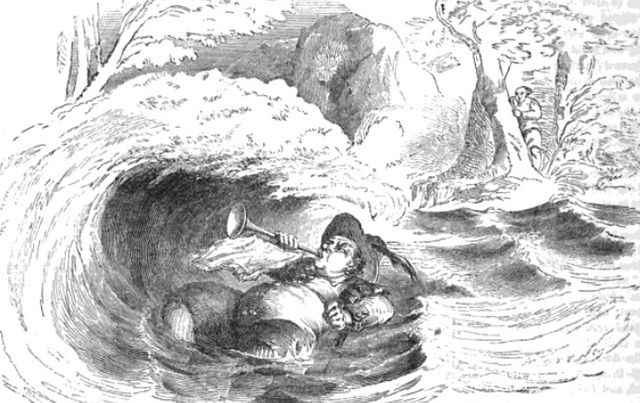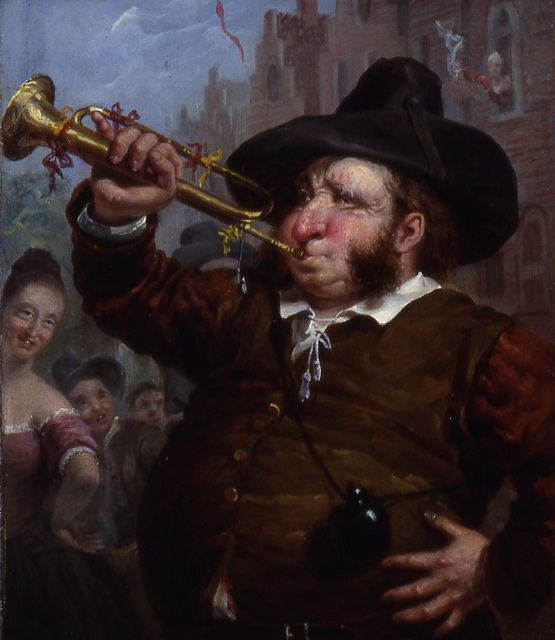Artist-Led Tour of "ENCORE" Photo Exhibit w/ Mark S. Kornbluth
Join photographer Mark S. Kornbluth for a visual exploration of NYC's Broadway theaters at Cavalier Galleries!


Spuyten Duyvil sits high above the Hudson River, separated from Manhattan by a meandering tidal estuary connecting the Hudson and Harlem Rivers. Dutch settlers first recorded the name Spuyten Duyvil in 1647. It is thought to refer either the turbulent watercourse itself (which the natives called Muscoota), or to a bubbling freshwater spring at the base of Inwood Hill.

The Last Blast of Anthony the Trumpeter, from the U.S. Magazine of Science and Art, 1856
Another explanation for the origin of the area’s name comes from the vivid imagination of Washington Irving, in the book Knickerbocker History of New York. As the story goes, heavy rains pelted sleepy Dutch farmhouses on a cool summer night as Anthony Van Corlaer rode hard towards the northern tip of Manhattan. Sent by Peter Stuyvesant to warn settlers of an impending attack by the English, he was unable to call the ferry over the roaring thunder. Unfazed, the intrepid messenger leaped into Muscoota creek, bellowing that he would make it “in spite of the Devil!” He was halfway across when a menacing fish snatched his leg. Struggling to free himself from the grips of the massive river monster, he tired. Realizing his fate, he brought his trumpet to his lips and let out a shrill blast as he was pulled beneath.
This tale is entertaining, but how much of it is based in fact? Anthony Van Corlaer was indeed a real person. Arriving in New Amsterdam by 1644, he was soon well known about town for his portly stature and bulbous nose. He was related to schoolmaster Jacob Van Corlaer, namesake of Corlears’ Hook on the Lower East Side. A garrison trumpeter for the Dutch West India Company, he accompanied Dutch officials on a trip to meet with the English in Massachusetts. He was also with Peter Stuyvesant when the Dutch took over New Sweden in 1655.
Several native settlements were near Spuyten Duyvil. On the Manhattan side of the creek was the village of Shorakapok, “the wet place,” namesake of Kappock Street. It was here that Peter Minuit purchased Manhattan in 1626, under the shade of a great tulip tree. On the Bronx side was Nipnichsen, “the muddy place.” In 1609, Henry Hudson anchored the Half Moon in the creek to weather a storm; his first mate Robert Juet noted the good ground of Berrian’s Neck and the distinctive “white greene” of Marble Hill (then connected to Manhattan).

Anthony Van Corlaer and Peter Stuyvesant, by John Quidor, 1839
New York native Washington Irving had an encyclopedic knowledge of New York City history and the lineage of old Dutch families. He may have based some of his tale on Arendt Van Corlaer, who Anthony was also distantly related to. Arendt founded Schenectady in 1662 and married Antonia Slagboom, the widow of Jonas Bronck, namesake of the Bronx. In 1667, he drowned on Lake Champlain in upstate New York during a ferocious storm; according to legend, he was struck down by the Devil himself.
A viscous mossbunker grabbed Anthony Van Corlaer, but some believe that this was an attack by a bull shark. If that is true, then this is one of the earliest recorded shark attacks in the New World. Of course, it is most likely that Van Corlaer drowned after underestimating the depth and might of the creek. People could wade across during low tide (this is the origin of the name for nearby Fordham), but during other times it was tremendously dangerous due to the large tidal range.

Portrait of Anthony the Trumpeter, by Charles Loring Elliott, 1858. Image from Wikimedia Commons.
As an area with such an incredible amount of history, Spuyten Duyvil has a special place in the myth and lore of old New York. Its unique story, which blurs the lines between fact and fiction, paints a lively picture of New Amsterdam.
Next, read about the Origin of more NYC Neighborhood Names. For more on the area check out Vintage Photos of Inwood. Get in touch with the author @Discovering_NYC.
Subscribe to our newsletter